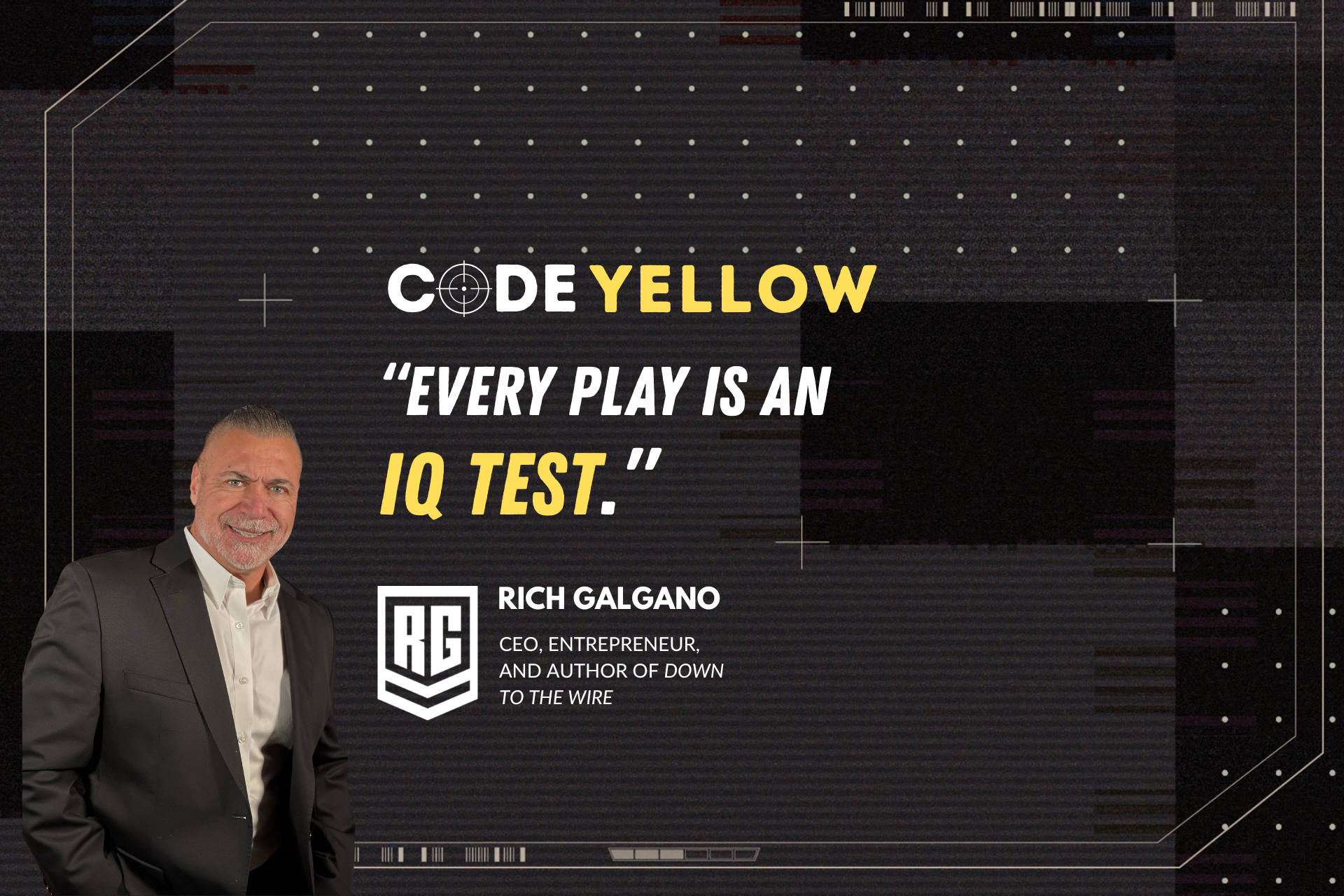The Origins of Code Yellow: How Awareness Becomes Power
By Rich Galgano
Code Yellow wasn’t something I planned—it was something that hit me in the moment. It was during one of my business and sales seminars, talking to a group of college-age kids, trying to hammer home a fundamental truth:
Situational awareness is everything.
It doesn’t matter if you’re in sales, business, negotiations, or life itself—if you’re not aware of what’s happening around you, you’re already losing.
To drive the point home, I threw out a quick analogy: The Street Test.
Imagine you’re walking alone down a dimly lit street late at night. You’re heading home. Coming toward you on the opposite sidewalk are two shady-looking characters.
At that moment, you have two choices:
- You can be head down in your phone, lost in TikTok or a text thread, completely oblivious to your surroundings.
2. You can be engaged—tracking the situation, running the scenarios:
- What’s my exit strategy?
- What’s the layout of the street? Any open stores? A gas station? A police station nearby?
- Do I have anything on me for self-defense? A plan?
- If something happens, what’s my next move?
And right there, it clicked. The difference between being a victim or not… is awareness.
And as I finished explaining this, I instinctively said: “That’s Code Yellow.”
Boom. The Rich Galgano Doctrine of Code Yellow was born.
What Is Code Yellow?
Code Yellow isn’t just an idea—it’s a mental operating system.
It’s the difference between being reactive and proactive.
It’s the difference between owning the moment and getting blindsided.
It’s the foundation for how we move, think, and execute.
Code Yellow is about awareness as a strategy.
It applies to:
- Sales – Reading the customer before they speak, knowing objections before they happen.
- Business – Seeing where the market is going before your competitors do.
- Negotiations – Sensing hesitation, tracking body language, understanding leverage.
- Everyday Life – Walking into a room and knowing who’s in charge, who’s posturing, and what’s really happening.
The Origins: Jeff Cooper’s Influence
I didn’t invent the term “Code Yellow.” The inspiration came from Jeff Cooper, a self-defense and military tactics legend.
Cooper created a color-coded system for situational awareness, originally used for personal security:
- White – Oblivious. Walking around blind.
- Yellow – Aware. Engaged. Tracking the environment.
- Orange – Identified a threat. Preparing to act.
- Red – Time to act. Fight or flight.
But here’s the difference: I don’t have four colors. I only have two.
- Code White – You’re oblivious, you don’t see what’s coming, you’re already losing.
- Code Yellow – You’re aware, engaged, tracking everything.
That’s it. No middle ground. No hesitation.
In my doctrine, if you’re truly Code Yellow, you don’t need an “Orange” or “Red.”
Because if you’re in Code Yellow, you already know when and how to act.
Why We Deploy Code Yellow
Because the world is full of Code White thinkers:
- They react instead of anticipate.
- They follow instead of lead.
- They hope instead of execute.
- You ever wonder why some people always seem to be in the right place at the right time?
- Why some athletes always know where the ball is going?
- Why some business owners always seem to make the right move before the market shifts?
That’s not luck. That’s Code Yellow.
Code Yellow in Action
I’ve been in negotiations where the guy across the table starts over-explaining, stalling, fumbling.
That’s a tell. That’s leverage. That’s my cue to strike.
And the best part? He doesn’t even know he’s giving me that information.
Because he’s Code White.
Code Yellow gives you the ability to see the play before it happens.
The Six Core Questions of Code Yellow
The foundation of Code Yellow comes down to six non-negotiable questions:
Who. What. When. Where. Why. How.
If you aren’t asking these six questions, you are not in Code Yellow:
- Who – Who’s in the room? Who’s really in charge? Who’s posturing?
- What – What’s happening? What’s the move before the move?
- When – When do I speak? When do I act? Timing is everything.
- Where – Where is the leverage? Where is the opportunity?
- Why – Why is this happening now? Why are they saying what they’re saying?
- How – How do I position myself to win? How do I control the frame?
If you’re not constantly running through these, you’re walking into conversations, deals, and life itself unprepared.
And unprepared people lose.
How Code Yellow Wins in Business & Life
Code Yellow is not just about awareness—it’s about execution.
You don’t just see what’s happening—you know how to respond.
Code Yellow thinkers:
- Control the conversation.
- Dictate the pace.
- Frame the situation to their advantage.
People in Code White? They’re being controlled—by the market, by the competition, by the person in Code Yellow sitting across from them.
Final Thoughts: Get Out of Code White
Code White is easy.
Code Yellow is hard.
But when you train yourself to always ask:
Who. What. When. Where. Why. How.
…every single day… in every single conversation… in every single meeting…
You will...
dominate your field.
walk into every room with unshakable confidence.
never be blindsided again.
And when that happens? You’ll never want to go back.
Welcome to Code Yellow.
Are You Ready to Deploy Code Yellow?
Because in a world where most people are walking around blind, the ones who are truly aware?
They run the game.











